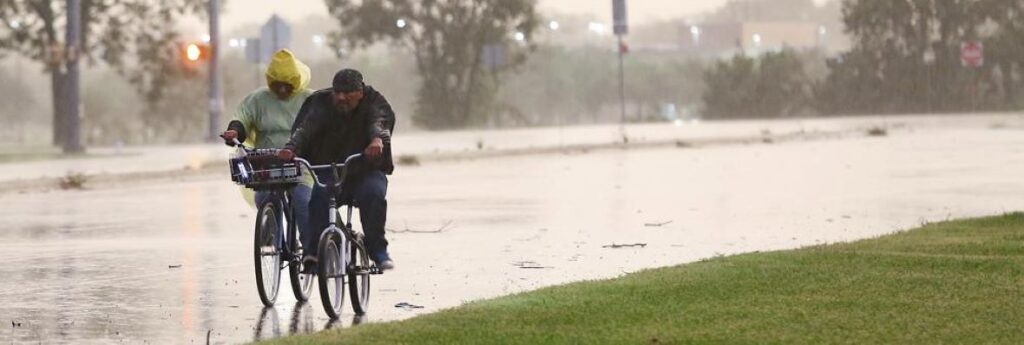Tropical Storm Nicholas hit the Texas coast early Tuesday as a hurricane and dumped more than 30.5 cm of rain along the same area swamped by Hurricane Harvey in 2017, drenching storm-battered Louisiana, knocking out power to hundreds of thousands of people and bringing the potential for life-threatening flash floods across the US Deep South.
Nicholas, which had been producing winds of 95 kph, made landfall on the eastern part of the Matagorda Peninsula and was soon downgraded to a tropical storm, by the National Hurricane Center in Miami. Nicholas was the 14th named storm of the 2021 Atlantic hurricane season.
Galveston saw nearly 35 cm of rain from Nicholas while Houston reported more than 15 cm of rain — a fraction of what fell during Harvey, which dumped more than 152 cm of rain in southeast Texas over a four-day period.
The storm was expected to move slowly over southeastern Texas on Tuesday and over southwestern Louisiana on Wednesday, at which point is was expected to weaken into a tropical depression that could dump up to 51 cm of rain in parts of central and southern Louisiana.
Much of Texas’ coastline was under a tropical storm warning that included potential flash floods and urban flooding. Texas Gov. Greg Abbott said authorities placed rescue teams and resources in the Houston area and along the coast.
In Houston, officials worried that heavy rain could inundate streets and flood homes. Authorities deployed high-water rescue vehicles throughout the city and erected barricades at more than 40 locations that tend to flood, Mayor Sylvester Turner said Monday.
“This city is very resilient. We know what we need to do. We know about preparing,” said Turner, referencing four major flood events that have hit the Houston area in recent years, including devastating damage from Harvey.
Meteorologist Kent Prochazka of the National Weather Service said that Nicholas’ winds downed trees in coastal counties and caused some gas stations to lose awnings.
“Right before it made landfall, it abruptly intensified into a hurricane and as it moved inland, the pressures began to rise with it. The winds have relaxed slightly and now we’re getting down into tropical storm force (winds),” he said on Tuesday.
CenterPoint Energy reported that over 400,000 customers lost power as the storm rolled through Houston.
Numerous school districts along the Texas Gulf Coast cancelled classes Monday because of the incoming storm. The Houston school district, the state’s largest, as well as others, announced that classes would be cancelled on Tuesday. The weather threat also closed multiple COVID-19 testing and vaccination sites in the Houston and Corpus Christi areas and forced the cancellation of a Harry Styles concert scheduled for Monday evening in Houston.
Nicholas brought rain to the same area of Texas that was hit hard by Harvey, which was blamed for at least 68 deaths, including 36 in the Houston area. After Harvey, voters approved the issuance of US$2.5 billion in bonds to fund flood-control projects, including the widening of bayous. The 181 projects designed to mitigate damage from future storms are at different stages of completion.
Louisiana Gov. John Bel Edwards declared a state of emergency Sunday night, ahead of the storm’s arrival in a state still recovering from Hurricane Ida and last year’s Hurricane Laura and historic flooding.
The storm was expected to bring the heaviest rainfall west of where Ida slammed into Louisiana two weeks ago. Ida has been blamed for 86 deaths throughout the United States. Across Louisiana, about 95,000 customers remained without power Tuesday morning, according to the utility tracking site poweroutage.us.
Colorado State University hurricane researcher Phil Klotzbach said via Twitter that only four other years since 1966 have had 14 or more named storms by Sept. 12: 2005, 2011, 2012 and 2020.

